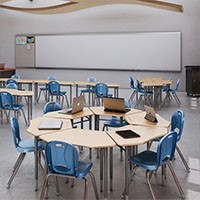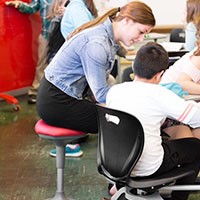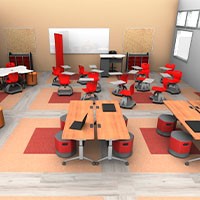
Flexible seating is a new and exciting trend in education, but the nature of this trend is that there are tons of options and a lot of open-ended suggestions for implementing flexible furniture in classroom layouts. Flexible seating research suggests that how students are arranged can help them learn, but different tasks are better suited to different layouts. For individual tasks, such as tests or lectures, both educators and researchers report that rows work best. When students are asked to work collaboratively, circular or semi-circular arrangements are most effective. Similar research has found that providing students with a variety of flexible seating options from standard chairs to yoga balls increases on-task behavior and improves attention. Researchers have shown and continue to show that flexibility and student ownership in the classroom is just as important as air quality, temperature and lighting.
Setting up a flexible classroom can be fun and easy, but it can also be a challenge to determine the difference between effective classroom layouts and simply trendy arrangements that you’ll regret by winter break. Luckily, desks and chairs that maximize the benefits of a flexible classroom are specifically designed to suit different teaching and learning styles just by rearranging them. Here are three research-based ways to design a flexible classroom.
Considering the benefits of structured and flexible classroom design can make it difficult to decide how best to arrange students. However, with lightweight collaborative tables educators can have the best of both worlds. Using tables and desks that fit together is a great way to group students together for activities or separate them when they’re having too much fun.
For early learning environments, half-moon tables from Sprogs are ideal for letting students develop social skills throughout the day in small groups while also having the ability to create larger group tables for class activities. For students in both elementary and middle school, bow tie tables provide individual desk space that can be combined to form small and large groups, allowing students to grow accustomed to more focused tasks such as tests or listening to lectures without immediately removing the comfort of tablemates.
In high school classrooms keeping desks in rows is even more important during tests, but letting students choose where their desk goes during the rest of class gives them a daily opportunity to make responsible decisions and helps them learn to manage their educational needs, two skills they will need as adults. Trapezoid tables and diamond-shaped whiteboard top mobile tables work perfectly as individual desks arranged in rows. With smooth casters attached, students can wheel them into pairs or any other group formations in a matter of seconds. Sit-to-stand desks are equally versatile and provide more active students with a productive alternative to sitting.
Most tables have convenient adjustable-height legs that can suit every student, every year. Tables with optional casters make moving desks easy for students, or the wheels can be replaced with glides to discourage unwanted movement. When teachers ask students to move their desks this not only gives the students a feeling of ownership over a task, but also prevents the teacher from having to spend time rearranging the room. With attached book boxes or add-on rail kits with totes, students can keep their supplies close by no matter where their desk is. Utilizing flexible tables means classrooms can always be just a few minutes away from being transformed to perfectly accommodate both individual and group activities.
Energetic students are exciting, fun and at times...a challenge. Flexible classroom seating helps manage student energy and is another important step to creating a flexible learning environment that accommodates every student’s needs. Adjustable-height wobble stools are great for active students regardless of their size and rolling chairs let students move while they think without being disruptive.
Soft seating is a lightweight option with a variety of colorful shapes and sizes available. From cube and cylindrical stools to gear and puzzle piece shaped seats, there are plenty of choices for flexible classrooms. Our soft seating buying guide can help you find seating that fits your ideal classroom design. Even padded floor seats and exercise balls can offer students a comfortable way to sit while providing extra seating for other areas of the classroom.
Alternatives to traditional chairs allow students to burn energy without needing to leave their desks. Flexible classroom seating is a simple way to let students have some control over their learning environment, making them feel like their opinions and preferences are valued.
Creating multiple spaces in a classroom not only encourages activities like reading and drawing, but also provides more areas for students to learn from. Splitting a classroom adds a ton of flexibility to a learning environment. Room dividers are an easy option that can reduce noise to and from separated groups. A dual-sided mobile markerboard can also serve as a divider, but with the added benefit of leaving room for notes on current lessons, student ideas and collaboration. However, dividers aren’t necessary for successful flexible classroom areas. With just a corner of the room, unique spaces are more than possible.
Art-focused areas make clean up easy and give students something to do when they finish their work early. Adding a table with storage is a good way to keep supplies organized and provides a space for fun crafts. Student easels are another convenient solution to keeping art activities contained while letting students draw or paint together.
Reading corners can be outfitted with soft seating that students can use to sit, lean or lay on while getting absorbed in a new story. A couch with tablet arms easily marks the entrance to a new space within the same room, while beanbags and floor pillows offer a relaxing reading experience. Inviting lounge seating paired with a colorful rug and a sturdybookcase can make students look forward to curling up with a good book.
Study nooks can help advanced students continue learning or provide a quiet space for others to do a bit more practice. Study carrels are perfectly designed for focused reading or using a device for web-based exercises. A mobile book cart can be a convenient place to store encouraged reading materials or electronic supplies like headphones for listening activities.
Makerspace areas give students a chance to experiment with STEM concepts. With the creation station set, a makerspace workshop can be formed using just one wall of your room. In classrooms with more limited space, a 3D printer cart is perfect for giving students the opportunity to create their very own projects.
The trend of flexible classrooms is unlikely to disappear anytime soon and with more research being done every year, we may find that there are even more opportunities to optimize class layouts. For now, utilizing flexible furniture that can suit any learning style on the fly will provide schools and educators with the tools to help students succeed for years to come.
Have questions? We’re here to help! Our experts are available by phone at 1-800-260-2776. You can also get personalized assistance through our or by emailing us. We’re available Monday-Friday, 8am-7pm.
Sources
Merrill, Stephen. “Flexible Classrooms: Research Is Scarce, but Promising.” Edutopia, George Lucas Educational Foundation, 14 June 2018, https://www.edutopia.org/article/flexible-classrooms-research-scarce-promising.
Klein, Alyson. “Flexible Seating: Collaboration Catalyst or Classroom Disaster?” Education Week, 21 January 2020, https://www.edweek.org/teaching-learning/flexible-seating-collaboration-catalyst-or-classroom-disaster/2020/01.
Havig, Jenna. “Advantages and Disadvantages of Flexible Seating”. Minot State University, ProQuest Dissertations Publishing, 27 June 2017. https://www.proquest.com/openview/acb159485 a636303e2b8f4e1b2f54474/1?-origsite=gscholar&cbl=18750.





